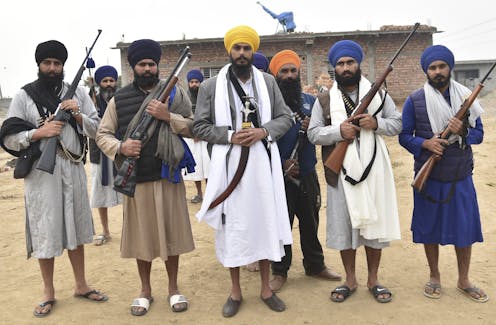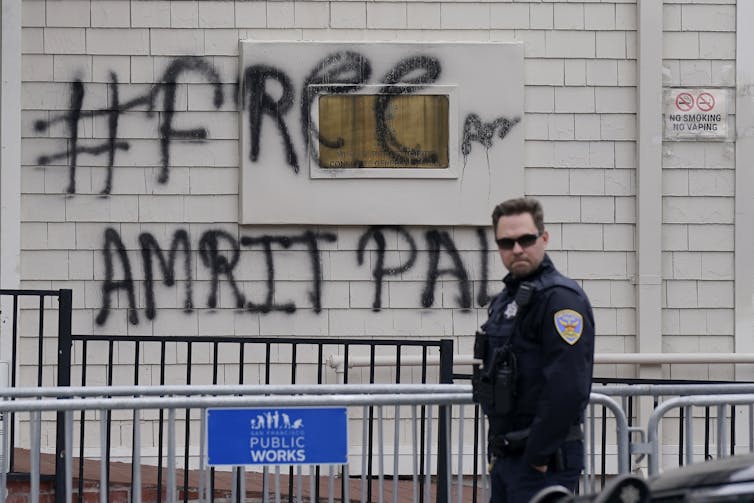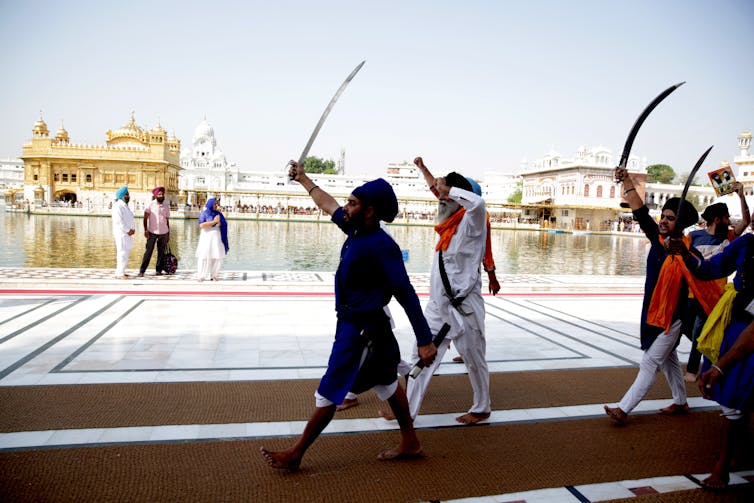Source: The Conversation (Au and NZ) – By Amitabh Mattoo, Honorary Professor of International Relations, The University of Melbourne

Prabhjot Gill/AP
It is not surprising that recent acts of vandalism by suspected Sikh separatists in Australia and North America have generated a sense of déjà vu.
In March, groups of separatists vandalised the Indian consulate in San Francisco. Another group of separatists blocked the entrance to the Indian consulate in Brisbane, forcing it to close temporarily. This followed attacks on three Hindu temples in Australia, allegedly by supporters of a group called Sikhs for Justice.

Jeff Chiu/AP
Tensions are also rising in India over the same Sikh separatist movement, with sporadic bouts of violence and the recent arrest of a firebrand preacher and independence leader, Amritpal Singh, under India’s National Security Act.
Elsewhere, the alleged military chief of a Sikh separatist group, Paramjit Singh Panjwar, was gunned down in Lahore, Pakistan, last week. There was no immediate claim of responsibility.
The separatists demand the creation of a Sikh state, “Khalistan,” in the north of India. In various cartographic fantasies, this new state would include the Indian capital of New Delhi and Lahore, which which was the capital of the great Sikh leader, Ranjit Singh, in the early 19th century.
Are these recent acts marking the revival of a full-blown Sikh separatist movement like the one India saw in the 1980s?
Nearly four decades ago, the demand for a separate homeland for Sikhs generated widespread terror, particularly in the Indian state of Punjab. It radicalised sections of the overseas Indian diaspora, as well.
A violent history
There was some degree of disaffection within the Sikh community following the split of Punjab between Pakistan and India in the partition of 1947. In later years, Sikhs demanded certain things from the Indian government (for instance, better water-sharing rights and greater linguistic protection). Some also expressed a deeper and more forceful assertion of their religious identity.
This latent sense of alienation and insecurity was hijacked in the 1980s by militant groups backed by Pakistan, especially those sworn to the leadership of the controversial Jarnail Singh Bhindranwale, whose followers occupied the Akal Takht in the Golden Temple Complex in 1984 – the most important religious site for Sikhs.

Raminder Pal Singh
Then-Prime Minister Indira Gandhi ordered the Indian Army to flush out the terrorists, killing many civilians as well. In the aftermath, Gandhi was assassinated by her personal Sikh security guards.
Less than a year later, an Air India plane flying from Montreal to Mumbai was blown up in mid air, killing more than 300 passengers. After serving two decades behind bars, Inderjit Singh Reyat – the only person convicted – was released in February 2017 by Canadian authorities.
However, by the early 1990s, a combination of policies by the government – both carrots and sticks – and the inherent pragmatism of the Sikhs had restored peace in Punjab.
Read more:
UK role in 1984 temple raid will affect British Sikh identity
Sikhs in contemporary society
The current acts of violence and vandalism do not have the potency to be sustainable, nor do they have much support within India or the Sikh diaspora.
There are more than 30 million Sikhs worldwide, with the majority in the Indian state of Punjab.
Punjab remains a symbol of India’s growth story. And within India, the Sikhs are seen as a remarkable community: hardworking, resilient and mostly without a strong caste-based social hierarchy. They have traditionally thrived in the security forces and as agriculturalists.
Sikhism was founded in the 15th century, and is based on the spiritual teachings of Guru Nanak. The last of ten gurus to follow him, Gobind Singh, organised the Sikhs into a martial fighting force, the Khalsa.
Today, their teachings are collected in the holy book, Granth Sahib, which serves as the life guide for Sikhs.
Read more:
Who are the Sikhs and what are their beliefs?
The Sikhs have carved out a niche identity abroad as mostly loyal, reliable and law-abiding citizens who have done well, even in times of great adversity. Their temples, called gurdwaras, are open to all faiths and the karah prasad, a simple lunch of sweet pudding, is offered to visitors irrespective of their views or standing.
US President Joe Biden recently nominated a Sikh, Ajay Banga, as the president of the World Bank.
Could the violence of the 1980s be repeated?
There are some similarities between the Punjab of today and that of the 1980s. But this is only at the superficial level.
For one, the problems today are identifiable and manageable. These include unemployment and a lack of opportunities for young people, widespread substance abuse, discontent among farmers over controversial laws that have since been rescinded, and a lack of forward-thinking leadership.
For another, there is only support at the fringes for the separatists, both within Punjab and in the diaspora.
Admittedly, the decline of the traditional political parties in Punjab (Congress and the Akali Dal) has created a power vacuum. This space has been occupied by the upstart Aam Aadmi Party (the Ordinary Man’s Party), which is currently governing Punjab, and groups like Waris Punjab De (Heirs to the Real Punjab), led by the firebrand, Amritpal Singh.
Singh returned to Punjab in 2022 after years of working in Dubai as an ostensible social reformer. He campaigned against drug use and for puritanical Sikihism – but also advocated for a separate Sikh state of Khalistan.
With increasing radicalisation, the situation could potentially worsen in the state. The political vacuum needs to be filled with legitimate, well-organised, politically sound voices. This is even more crucial after the recent death of Prakash Singh Badal, a five-time chief minister of Punjab, who had been a voice of sanity and statesmanship.
The Indian government and key stakeholders in Punjab seem well aware of the dangers of letting the situation worsen once again. There is a deep consciousness they must not let history repeat itself.
![]()
The authors do not work for, consult, own shares in or receive funding from any company or organisation that would benefit from this article, and have disclosed no relevant affiliations beyond their academic appointment.
– ref. Is a Sikh separatist movement seeing a resurgence four decades after sparking terror in India? – https://theconversation.com/is-a-sikh-separatist-movement-seeing-a-resurgence-four-decades-after-sparking-terror-in-india-204533







